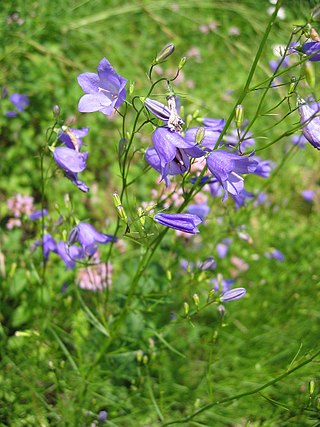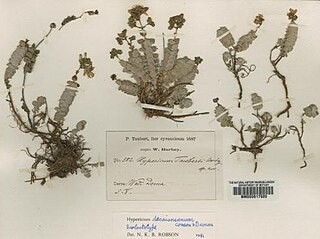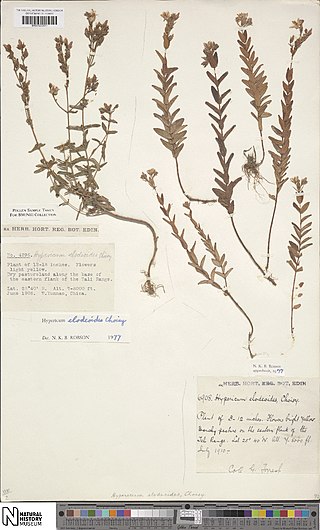
Campanula rotundifolia, the harebell, Scottish bluebell, or bluebell of Scotland, is a species of flowering plant in the bellflower family Campanulaceae. This herbaceous perennial is found throughout the temperate regions of the northern hemisphere. In Scotland, it is often known simply as bluebell. It is the floral emblem of Sweden where it is known as small bluebell. It produces its violet-blue, bell-shaped flowers in late summer and autumn.

Lumnitzera is an Indo-West Pacific mangrove genus in the family Combretaceae. An English common name is black mangrove. Lumnitzera, named after the German botanist, Stephan Lumnitzer (1750-1806), occurs in mangroves from East Africa to the Western Pacific, and northern Australia.

Hypericum aegypticum is a species of flowering plant of the St. John's wort family (Hypericaceae) which is native to the Eastern Mediterranean. It was described by Carl Linnaeus in the second volume of his Species Plantarum in 1753, who named it after Egypt despite it not being distributed there. The plant is commonly known as shrubby St. John's wort or Egyptian St. John's wort in English. Like other members of section Adenotrias, it is found among limestone rocks in coastal areas. While it has been evaluated as threatened on the island of Malta, the species has no legal protections.
Hypericum collinum is a flowering plant in the family Hypericaceae which is found in Mexico.
Plants of the World Online (POWO) is an online database published by the Royal Botanic Gardens, Kew. It was launched in March 2017 with the ultimate aim being "to enable users to access information on all the world's known seed-bearing plants by 2020". The initial focus was on tropical African Floras, particularly Flora Zambesiaca, Flora of West Tropical Africa and Flora of Tropical East Africa.

Hypericum cerastioides is a species of perennial flowering plant in the St. John's wort family, Hypericaceae. It is the only species in the section Hypericum sect. Campylopus.

Hypericum sechmenii, commonly called seçmen kantaronu in Turkish which means Seçmen's St. John's wort in English, is a rare species of flowering plant of the St. John's wort family (Hypericaceae) that is found only in the Eskişehir Province of central Turkey. It was described by Turkish botanists Atila Ocak and Onur Koyuncu who named the species in honor of Özcan Seçmen, a fellow Turkish botanist. Found in the crevices of exposed limestone, it is a perennial herb which grows in clusters of stems 3–6 centimetres tall and blooms June to July with bright yellow five-petalled flowers. Formally described in 2009, the species was first collected in 2006 and has since been found in only two localities with an estimated population of less than 250.

Hypericum przewalskii, commonly called Przewalski's St. John's wort, is a flowering plant in Hypericumsect. Roscyna that is native to China.

Hypericum fasciculatum, known as peelbark St. Johnswort or sandweed, is a species of flowering plant in the St. Johnswort family, Hypericaceae, native to the southeastern United States. It is found from eastern North Carolina, south to southern Florida, west to eastern Louisiana. Kew's Plants of the World Online database also notes that it occurs in Cuba, though Cuba is not listed in several other sources. It was first described in 1797 by Jean-Baptiste Lamarck.
Hypericum steyermarkii is a species of flowering plant in the genus Hypericum, and is the only species in Hypericum sect. Santomasia. The species is found in the Chiapas province of Mexico as well as in Guatemala. The species was named for the collector of its holotype, Julian Steyermark, an American botanist.
Hypericum fissurale, known as cracked St. John's wort, is a flowering plant in the St. Johns's wort family (Hypericaceae) endemic to northeastern Turkey. It is considered critically endangered on the IUCN Red List due to its very limited distribution and declining population. It was first formally named by Jurij Nikolaewitch Woronow in 1912. It is a small perennial herb in the section Hypericum sect. Taeniocarpium, reaching around 22 cm (8.7 in) in height. Like most Hypericum species, it has flowers with five yellow petals and numerous stamens. Hypericum fissurale is closely related to Hypericum armenum.
Hypericum minutum is a flowering plant in the genus Hypericum, sect. Adenosepalum.

Hypericum coadunatum is a species of flowering plant of the St. John's wort family (Hypericaceae) that is found in the Canary Islands.
Hypericum psilophytum is a species of flowering plant of the St. John's wort family (Hypericaceae) that is found in Morocco and Algeria.
Hypericum scruglii is a species of flowering plant of the St. John's wort family (Hypericaceae) that is found in Sardinia.
Hypericum somaliense is a species of flowering plant of the St. John's wort family (Hypericaceae) that is found in Somalia.

Hypericum tomentosum is a species of flowering plant of the St. John's wort family (Hypericaceae) that is found in the western Mediterranean.

Hypericum decaisneanum is a species of flowering plant of the St. John's wort family (Hypericaceae) that is found in the Libya.

Hypericum elodeoides, commonly called the Himalayan St. John's Wort, is a species of flowering plant of the St. John's wort family (Hypericaceae).










